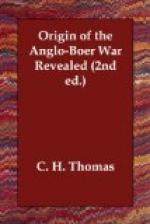Within 200 or 300 miles from the Drakensberg slopes the country is well-watered, and the rainfall ample and generally regular, but westwards this abundance progressively decreases with a more tardy and precarious rainy season, occasioning at times severe droughts accompanied with correspondingly protracted and very hot weather.
Those high plains make up one vast green sward from the time of the spring rains in September to April. From May the absence of rain, together with the night frosts, shrivel up the herbage, giving the country a pale-brown aspect. This continues until the return of spring, varied with large expanses of black, caused by accidental or intentional grass fires, and here and there a few green spots in specially sheltered and moist localities.
Those burnt spaces may extend for miles, and are for the time veritable deserts. The landscape being quite black and the atmosphere generally very clear, it is obvious that objects of any lighter colour would be conspicuous at very long distances: an ideal background for khaki targets.
Most of the land is well suited for agriculture, but by far the largest proportion is as yet used only for raising sheep, horses and cattle. Angora goats also thrive in the hillier parts. About forty years ago the Karoo plains, the Orange Free State, and Transvaal were, so to say, monopolised by milliards of game. Standing upon an eminence or a swell one could see in all directions, as far as the eye could reach, innumerable herds of all sorts of game grazing, resting or gambolling; the different kinds would be ranged in separate groups and could be distinguished by their special colours—the black-looking wildebeest (gnu) next to the striped quag-gas, the white-flanked springbocks, blesbocks with a blaze on their foreheads, the larger elands and other kinds of the antelope species. Almost all those vast herds have disappeared since, having been killed off by natives and Boers for their hides and for food, or else scared away farther north, where rinderpest extirpated nearly all the rest in 1895-1897.
In the earlier days, and even not so long ago in some parts, the farmers’ crops required guarding during the night against the depredations of game. This is still so in the north-western plains of the Cape Colony, as already remarked. In May most of the Harrismith district farmers and those of the Transvaal high veldt move their sheep, horses and cattle to winter in Natal, Swaziland, and to the other extensive low lands most adjacent, to return after the spring rains in September or October. Sheep and horses could not with safety remain longer in those warm regions, as then the fatal malarial blaauwtong begins there to attack sheep, and horse sickness becomes virulent as well. The high veldt, as said before, is exempt from that danger.
Some of the wealthier farmers can arrange it so that they and their families can winter at their comfortable high-veldt homes and send attendants with their cattle to the low veldt, while others, not so well favoured, must close up their houses and accompany their flocks to winter in the warm tracts, where they live in their wagons and tents and escape the outlay for winter clothing.




